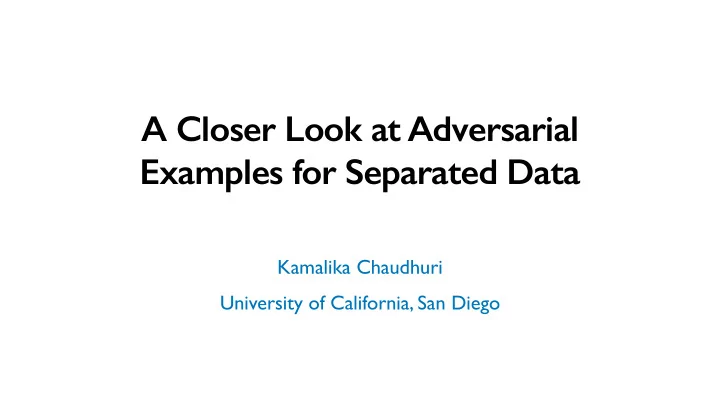

A Closer Look at Adversarial Examples for Separated Data Kamalika Chaudhuri University of California, San Diego
Adversarial Examples Gibbon Panda Small perturbation to legitimate inputs causing misclassification
Adversarial Examples Can potentially lead to serious safety issues
Adversarial Examples: State of the Art A large number of attacks A few defenses Not much understanding on why adversarial examples arise
Adversarial Examples: State of the Art A large number of attacks A few defenses Not much understanding on why adversarial examples arise This talk: A closer look
Background: Classification Given: ( x i, y i ) Vector of Discrete features Labels Find: Prediction rule in a class to predict y from x
Background: The Statistical Learning Framework - + Training and test data drawn from an underlying distribution D
Background: The Statistical Learning Framework - + Training and test data drawn from an underlying distribution D Goal: Find classifier f to maximize accuracy ( x,y ) ∼ D ( f ( x ) = y ) Pr
Measure of Robustness: L p norm A classifier f is robust with radius r at x if it predicts f(x) for all x’ in k x � x 0 k p r
Why do we have adversarial examples?
Why do we have adversarial examples? - Data Distributional distribution Robustness +
Why do we have adversarial examples? - Data Distributional distribution Robustness + Too few - Finite Sample samples Robustness +
Why do we have adversarial examples? - Data Distributional distribution Robustness + Too few - Finite Sample samples Robustness + Algorithmic Bad - Robustness algorithm +
Why do we have adversarial examples? - Data Distributional distribution Robustness + Are classes separated in real data?
r-Separation 2r 2r Data distribution D is r-separated if for any (x, y) and (x’, y’) drawn from D y 6 = y 0 = ) k x � x 0 k � 2 r
r-Separation 2r 2r 2r Data distribution D is r-separated if for any (x, y) and (x’, y’) drawn from D y 6 = y 0 = ) k x � x 0 k � 2 r r-separation means accurate and robust at radius r classifier possible!
Real Data is r-Separated Dataset Separation Typical r 0.1 MNIST 0.74 0.03 CIFAR10 0.21 0.03 SVHN* 0.09 0.005 ResImgnet* 0.18 Separation = min distance between any two points in different classes
Robustness for r-separated data: Two Settings Non-parametric Methods
Non-Parametric Methods k-Nearest Neighbors Decision Trees Others: Random Forests, Kernel classifiers, etc
What is known about Nonparametric Methods?
The Bayes Optimal Classifier Classifier with maximum accuracy on data distribution Only reachable in the large sample limit
What is known about Non-Parametrics? With growing training data, accuracy of non-parametric methods converge to accuracy of the Bayes Optimal
What about Robustness? Prior work: Attacks and defenses for specific classifiers Our work: General conditions when we can get robustness
What is the goal of robust classification?
What is the goal of robust classification? Bayes optimal undefined outside distribution Bayes optimal
The r-optimal [YRZC20] Bayes optimal undefined outside distribution x Bayes optimal r-optimal r-optimal = classifier that maximizes accuracy at points that have robustness radius at least r
Convergence Result [BC20] Theorem: For r-separated data, condi- tions when non-parametrics converge 2r to r-optimal in large n limit
Convergence Result [BC20] Theorem: For r-separated data, condi- tions when non-parametrics converge 2r to r-optimal in large n limit Convergence limit: r-optimal: Nearest neighbor, Kernel classifiers
Convergence Result [BC20] Theorem: For r-separated data, condi- tions when non-parametrics converge 2r to r-optimal in large n limit Convergence limit: r-optimal: Nearest neighbor, Kernel classifiers Bayes-optimal but not r-optimal: Histograms, Decision trees
Convergence Result [BC20] Theorem: For r-separated data, condi- tions when non-parametrics converge 2r to r-optimal in large n limit Robustness depends on training algorithm! Convergence limit: r-optimal: Nearest neighbor, Kernel classifiers Bayes-optimal but not r-optimal: Histograms, Decision trees
Robustness for r-separated data: Two Settings Non-parametric Methods Neural Networks
Robustness in Neural Networks A large number of attacks A few defenses All defenses show a robustness-accuracy tradeoff Is this tradeoff necessary?
The Setting: Neural Networks f(x) f Neural network computes function f(x) 0 Classifier output sign(f(x)) x
The Setting: Neural Networks f(x) f Neural network computes function f(x) 0 Classifier output sign(f(x)) x Robustness comes from Local Smoothness: If f is locally Lipschitz around x, and f(x) is away from 0, then f is robust at x
Robustness and Accuracy Possible through Local Lipschitzness f(x) f Neural network computes function f(x) 0 Classifier output sign(f(x)) x Theorem [YRZSC20] If distribution is r-separated, then there exists an f s.t. f is locally smooth and sign(f) has accuracy 1 and robustness radius r
In principle, no robustness-accuracy tradeoff In practice there is one What accounts for this gap?
Empirical Study 4 standard image datasets 7 models 6 different training methods - Natural, AT, Trades, LLR, GR Measure local Lipschitzness, accuracy and adversarial accuracy
Result: CIFAR 10
Observations Trades and Adversarial training have best local Lipschitzness Overall, local Lipschitzness correlated with robustness and accuracy - until underfitting begins Generalization gap is quite large - possibly a sign of overfitting Overall: robustness/accuracy tradeoff due to imperfect training methods
Conclusion: Why do we have adversarial examples? - Data Distributional distribution Robustness + Too few - Finite Sample samples Robustness + Algorithmic Bad - Robustness algorithm +
References Robustness for Non-parametric Methods: A generic defense and an attack, Y. Yang, C. Rashtchian, Y. Wang, and K. Chaudhuri, AISTATS 2020 When are Non-parametric Methods Robust? R. Bhattacharjee and K. Chaudhuri, Arxiv 2003.06121 Adversarial Robustness through Local Lipschitzness Y. Yang, C. Rashtchian, H. Zhang, R. Salakhutdinov and K. Chaudhuri, Arxiv 2003.02460
Acknowledgements Cyrus Yaoyuan Yizhen Hongyang Robi Ruslan Rashtchian Yang Wang Zhang Bhattacharjee Salakhutdinov
Recommend
More recommend